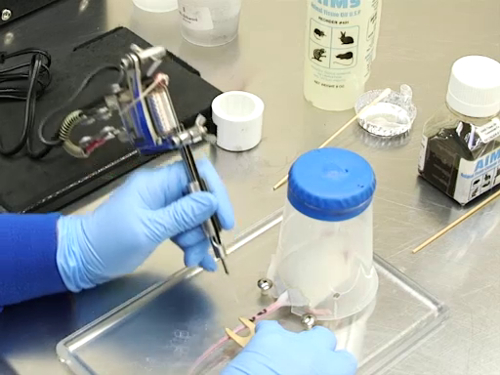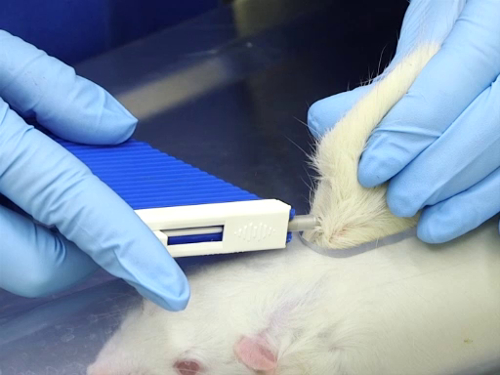설치류 식별 II
Overview
출처: 케이 스튜어트, RVT, RLATG, CMAR; 발레리 A. 슈뢰더, RVT, RLATG. 노틀담 대학교, IN
데이터 수집이 올바른지 확인하기 위해 동물 기록을 정확하게 유지해야 합니다. 기록은 케이지 카드에 대한 정보 유지에서 각 동물에 대한 모든 관련 정보가 있는 자세한 데이터베이스를 보유하는 것까지 다양합니다. 기록 보관의 주요 구성 요소는 연구 동물의 개별 식별입니다. 마우스와 쥐를 식별하는 데 적합한 다양한 방법이 있습니다. 이 비디오는 문신, 마이크로칩 배치 및 임시 식별 방법에 대한 절차 적 기술을 설명하고 각각의 이점을 탐구합니다.
Procedure
1. 꼬리 문신
꼬리 문신은 동물을 다룰 필요없이 쉽게 읽을 수 있습니다.

그림 1. 성인 마우스에 꼬리 문신
- 제조업체의 지시에 따라 문신 장비를 준비하십시오. 소량의 잉크가 필요합니다. 검은 염료는 알비노 마우스 또는 쥐, 그리고 색소 마우스 또는 쥐에 대 한 녹색 염료에 사용 해야 합니다.
- 동물을 준비하여 식별합니다.
참고: 우려나 고통을 최소화하기 위해 꼬리 문신은 동물 주택 지역이 아닌 절차실에서 수행해야 합니다.- 움직임이 최소화되도록 적절하게 문신을 위해 동물을 억제합니다.
- 젖을 짜는 쥐는 문신 플랫폼의 볼트 아래에 컵의 입술을 고정하고 꼬
Application and Summary
References
- Robinson, V., Morton, D.B., Anderson, D., Carver, J.F.A., Francis, R.J., Hubrecht, R., Jenkins, E., Mathers, K.E., Raymond, R., Rosewell, I., Wallace, J., and Wells, D.J. 2003. Refinement and reduction in production of genetically modified mice. Laboratory Animals. 37:S1-S50.
- Schaefer, D.C., Asner, I.N., Seifert, B., Bürki, K., and Cinelli, P. 2010. Analysis of physiological and behavioural parameters in mice after toe clipping as newborns. Laboratory Animals. 44:7-13
- Castelhano-Carlos, M.J., Sousa, N., Ohl, F., and Baumans, V. 2010. Identification methods in newborn C57BL/6 mice: a developmental and behavioural evaluation. Laboratory Animals. 44: 88-103.
- Danneman, P.J., Suckow, M.A., and Brayton, C.F. 2013. The laboratory mouse. Second edition. New York, NY: CRC Press.
- Institute for the Laboratory Animal Research. 2011. Guide for the care and use of laboratory animals, 8th ed. Washington (DC): National Academies Press.
건너뛰기...
이 컬렉션의 비디오:

Now Playing
설치류 식별 II
Lab Animal Research
25.6K Views

설치류 취급 및 통제 기술
Lab Animal Research
174.6K Views

실험실 기본 관리
Lab Animal Research
28.0K Views

사육 및 이유의 기초
Lab Animal Research
35.7K Views

설치류 식별 I
Lab Animal Research
54.8K Views

화합물 투여 I
Lab Animal Research
100.6K Views

화합물 투여 II
Lab Animal Research
34.9K Views

화합물 투여 III
Lab Animal Research
31.5K Views

화합물 투여 IV
Lab Animal Research
51.7K Views

혈액 채취 I
Lab Animal Research
171.7K Views

혈액 채취 II
Lab Animal Research
73.3K Views

마취 유도 및 유지
Lab Animal Research
50.5K Views

설치류 수술에 대한 고려 사항
Lab Animal Research
22.5K Views

진단 부검 및 조직 수확
Lab Animal Research
58.1K Views

멸균 조직 수확
Lab Animal Research
34.8K Views
Copyright © 2025 MyJoVE Corporation. 판권 소유

